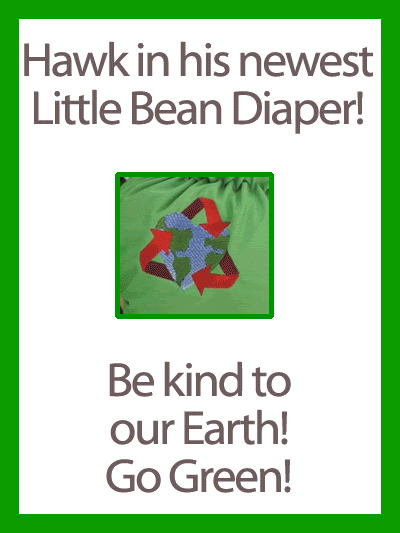5 Crazy Environmental Facts and Benefits of using Cloth Diapers | #earthday #ecofriendly #clothdiapers
Real Diaper Week – Day 2 (April 17th): Real Simple Real Diapers Waste Reduction – Environmental benefits
Everywhere you turn, you hear the economical benefits of cloth diapers, but the benefit that often goes overlooked is one of the biggest reasons to be concerned about for the sake of our childrens’ future on Earth.
This is one of my favorite diapers ever that Hawk had when he was little! I wish I still had it for Jett!

My favorite place to read about the environmental advantages of cloth diapering is The Real Diaper Association‘s website.
Here are a few of facts that will have you dropping your jaw!
When I first started cloth diapering, the number one fact that got my attention was:
1. Disposable diaper packages state that solid waste should be flushed down the toilet before throwing the diaper away, however less than 0.5% of fecal matter from disposable diapers actually get flushed!
Who even knew this? Who thinks to read the disposable diaper packaging? It never would have crossed my mind.
The second craziest fact that made me double-take is:
2. It is estimated that it takes disposable diapers 250-500 years go decompose.
A friend of mine once had a point! She said, long after we’re gone, and people start digging up artifacts (a little like we dig up dinosaurs), those in the future are going to think we idolized poop! They’ll dig in the landfills and find these preserved little packages of poop after everything else has decomposed!
What about this one?
3. If you have child in disposable diapers, they make up 50% of your household waste because it’s estimated that babies use about 6,000 diapers in their first two years of life! WOW!
One of the major arguments that non cloth diaper users try to pull out of their hats when trying to dispute the cost effectiveness of cloth diapers is the fact that you use a lot of water to wash your diapers, therefore making them no more friendly on the status of the water in our environment, however, what they fail to realize is:
4. To make and use disposables takes 2.3 times more water than when using cloth diapers.
2.3. How’s that for environmental friendliness!?
How many trees, do you think, were harmed in the production of the cloth diapers on my baby? If any, I’m fairly sure not as many as the disposables on the baby down the street!
5. 300 pounds of wood, 50 pounds of petroleum feedstocks, and (get this…) 20 pounds of chlorine are used to produce enough diapers for one baby a year.
And we wonder where our trees are going! Right back into the landfills, useless.
These are just the profound, top five facts that I like to share. You can read more about Real Diaper Facts as well as find the sources for these at RealDiaperAssociation.org.

Wow…you know your stuff! He is cute as heck in his new cloth diaper 🙂
I never thought about the packaging either. But we recycle all that. But it still has to be made!